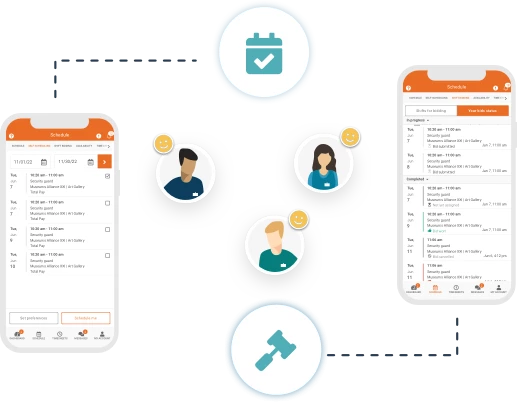In the ever-evolving world of business, effective employee management is the key to success. One essential tool in this regard is the use of employment rosters. These schedules not only help streamline operations but also contribute to increased productivity and job satisfaction.
In this blog post, we break down the significance of employment rosters, and their impact on productivity and satisfaction. We also look at how to optimize them for your organization’s success.
Understanding Employment Rosters
What Are Employment Rosters?

Employment rosters, often referred to as work schedules or staff schedules, are documents that outline when and where employees are expected to work. These schedules can cover various timeframes, from daily shifts to monthly assignments, depending on the needs of your organization. For some organizations, a roster may also cover multiple locations or multiple clients, which can be difficult to manage.
Why Are Employment Rosters Important?
- Resource Allocation: Employment rosters help allocate human resources efficiently. They ensure that the right number of employees with the required skills are available during peak work hours, minimizing overstaffing or understaffing issues.
- Time Management: They help employees plan their work hours, ensuring they are aware of their schedules in advance. This predictability improves work-life balance and reduces stress.
- Compliance: Rosters also help organizations comply with labor laws and union agreements by tracking working hours, breaks, and rest periods.
Boosting Productivity with Effective Rosters
1. Reduced Turnover
When employees have clear and consistent schedules, they are more likely to stay with your organization. High employee turnover rates can disrupt operations and lead to additional recruitment and training costs. Studies estimate that turnover costs per employee average 16% of earnings under $30,000 per year! However, turnover varies by wage and role of the employee. Effective employment rosters can reduce turnover and the associated expenses.
2. Enhanced Communication

Clear rosters foster better communication among team members. When employees know who they’ll be working with and when, they can collaborate more effectively, leading to improved overall productivity. When rosters are clear and given in advance, you are less likely to experience absenteeism and or missed shifts.
3. Optimal Staffing Levels
Properly planned rosters ensure that your workforce matches the workload. This prevents situations where employees are either overburdened or underutilized, promoting a balanced workload and higher productivity. It also means you are less likely to experience understaffing or overstaffing which can cause issues of their own such as increased costs and unhappy customers.
4. Employee Engagement
When employees have a say in their schedules or receive reasonable notice of changes, they feel valued and engaged. In fact, a whopping 83% of employees would like to provide more input in their roles, and your employee roster is the perfect opportunity for this. Engaged employees tend to be more committed to their jobs, resulting in increased productivity and job satisfaction.
Enhancing Job Satisfaction through Roster Flexibility
1. Work-Life Balance
Flexible duty rosters that consider employees’ personal commitments and preferences contribute to better work-life balance. This, in turn, enhances job satisfaction and reduces burnout.
2. Fairness and Transparency

Transparent rostering practices that distribute shifts fairly and consider seniority or performance can lead to higher job satisfaction. Employees appreciate equitable treatment and are more likely to stay motivated.
3. Reduced Stress
With clear and predictable schedules, employees experience less stress related to work. They can plan their lives around their work commitments, reducing the anxiety caused by last-minute changes.
Optimizing Employment Rosters
1. Use Employee Feedback
Regularly seek input from employees when creating schedules. Consider their preferences and needs as much as possible to build schedules that accommodate their lives. We talk about technology below, but the right tools will allow your employees to input their availability which can be used when building a roster.
2. Embrace Technology

Leverage employee scheduling software to automate the scheduling process. These tools can take into account various factors like employee availability, skills, and labor laws to create optimized schedules. They can also give you the tools you need to effectively manage a flexible schedule and give your employees more autonomy.
3. Monitor and Adjust
Regularly review roster data and gather feedback from both employees and managers. Use this information to fine-tune your scheduling process continually.
4. Provide Training
Ensure that managers and supervisors are trained in rostering best practices. This helps in creating schedules that align with organizational goals while considering employee well-being.
Employment rosters play a vital role in boosting both productivity and job satisfaction within your organization. By creating effective schedules that balance the needs of the business with those of your employees, you can build a motivated, engaged, and high-performing workforce. Remember, the key to success lies in understanding the importance of employment rosters, optimizing them, and using them as a tool for creating a positive work environment for all. If you want to learn more about how we can help you enhance your employee rosters, get in touch today or sign up for a free trial!





